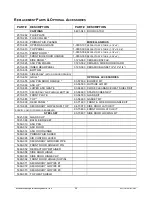
Hearthstone
Quality Home Heating Products, Inc
® Manchester Model 8360
22
Moisture content also plays a key role in the
performance of your stove. Wood freshly cut from a
living tree (green wood) contains a great deal of
moisture. As you might expect, green wood burns
poorly. You must season green wood before using it
in your wood stove. To season green wood properly,
split, stack, and allow it to air dry for a period of one
year. Green wood may provide less than 2000 Btu
per pound, whereas dry wood can provide up to
7000 Btu per pound.
Stack the firewood on skids or blocks to keep it off
the ground, cover only the top of the stack. Plastic or
tarps that cover the sides of the woodpile trap
moisture and prevent the wood from drying. As for
stacking, an old Vermonter said, "The spaces
between the logs should be large enough for a
mouse to get through, but not for the cat that's
chasing it."
CAUTION: DO NOT STORE FIREWOOD WITHIN
THE STOVE'S SPECIFIED CLEARANCES TO
COMBUSTIBLE MATERIALS.
B
UILDING
A
F
IRE
Once you understand the controls of your wood
stove and have the appropriate firewood, you are
ready to start a fire.
WARNING: NEVER USE GASOLINE, GASOLINE-
TYPE LANTERN FUEL, KEROSENE, CHARCOAL
LIGHTER FLUID, OR SIMILAR LIQUIDS TO START
OR 'FRESHEN UP' A FIRE IN THIS HEATER.
KEEP ALL SUCH LIQUIDS WELL AWAY FROM
THE HEATER WHILE IT IS IN USE.
When you light your first fires, the woodstove will
emit some smoke and fumes. This is normal “off-
gassing” of the paints and oils used when
manufacturing the woodstove. If you find it
necessary, open a few windows to vent your room.
The smoke and fumes will usually subside after 10
to 20 minutes of operation. The odor and smoke will
end once the stove is “cured”.
The first few fires of the season may produce other
odors from impurities that exist in the area
immediately surrounding the stove. Some potential
impurities are cleaning solvents, paint solvents,
cigarette smoke, and soot from scented candles, pet
hair, dust, adhesives, a new carpet, and new
textiles. These odors will dissipate over time. You
can alleviate these odors by opening a few windows
or otherwise creating additional ventilation around
your stove. If any odor persists, contact your dealer
or an authorized service technician.
If you adhere to the operating procedures in this
manual, the steel, cast iron, and refractory
components of your stove will give you many years
of trouble-free use. With use, the color of the
refractory panels will change and small fractures
may appear on the surface. These changes do not
affect the function of the stove. If a panel breaks
completely, it must be replaced
Avoid the following conditions that can cause the
glass, refractory panels, steel or cast iron pieces to
break:
Do not throw wood into the stove.
Do not use the door as a lever to force wood into
the stove.
Do not load wood encrusted with ice into a
burning stove - the thermal shock can cause
damage.
Do not use a manufactured log grate. Burn the
fire directly on the cast iron bottom of the
firebox.
N
ORMAL
O
PERATION
Prior to loading the stove, ensure the ash grate and
the ash pan are in place.
B
UILDING
A
F
IRE
F
OR
E
VERYDAY
U
SE
1) Open the front door and place five or six
double sheets of tightly twisted newspaper
in the center of the firebox. Arrange kindling
in a
tee-pee
configuration over
the
newspaper. Use approximately 10 pieces of
kindling, 1/2" (13 mm) in diameter and 10" to
16" (254 mm to 406 mm) long.
2) Fully open the primary air control by moving
the lever completely to the left.
3) Light the paper under the kindling. Leave the
front door slightly ajar momentarily until the
kindling begins to burn and draft begins to
pull.
4) Close the door and allow the fire to burn.
5) Once the kindling is burning, open the front
door and add logs, small at first, to build the
fire up. Ensure you keep the logs away from
the glass in front in order for the air-wash
system to work properly. Keep the front door
and ash pan closed while the stove is in use.
6) Once the fire is burning well, use the primary
air control to regulate the desired rate of
burn. Move the handle to the left to open the
primary air control for a high rate of burn; or
move it to the right for a low rate of burn.
The air control does not close completely.











































